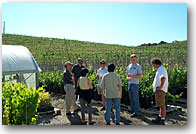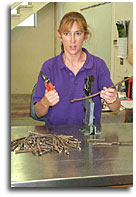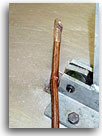
Tablas Creek Vineyard
by Eric Anderson
(excerpted from Vol.10 No.4, Journal du Vin, May 2002. …a visit on 5/30/02 to Tablas Creek in Paso Robles for a tour and tasting.)
 |
While attending the 2002 Hospice du Rhone festivities in Paso, we effectively used our "down-time" to visit a few (okay ...several) of the local wineries. Although most of the wineries were probably going to be attending HdR to pour their Rhone varietals, it's always fascinating to visit the winery and/or vineyards - I think you really get a better sense of the wines, and possibly a greater understanding of the appellation itself. Along these lines, one of the interesting things that has happened to the Paso Robles appellation in recent years was the arrival of the French clones - via Tablas Creek Vineyard.
It had been
awhile since I last visited Tablas Creek (1st
visit- 3/'00), so I was curious to see what changes might have taken
place. A small tour & tasting had been arranged to showcase the vineyard
& winemaking facility, as well as their burgeoning nursery business.
(Tablas Creek propagates rootstocks supplied to them originally by Ch.
Beaucastel.) Their full nursery produces French (Tablas) clones of Mourvédre,
Grenache Noir, Syrah, Counoise, Roussanne, Viognier, Marsanne, and Grenache
Blanc. The recent addition of some Pinot Noir mother vines to the nursery
might bring an interesting element to future domestic Pinot. Thus far,
Tablas clone vines have been sold to the likes of: Ridge, Qupé,
Bonny Doon, Beckmen, Andrew Murray, Cedarville, Zaca Mesa, L'Aventure,
Garretson, and Justin, as well as a few out-of-state producers.
Early On
|
Selected Tasting Notes: 2000 Tablas Creek Anthesis - Lots of pineapple and light spice in the nose. Crisp, lighter mouthfeel, just a touch of something medicinal. Not at all cloying or sweet-tasting. Made from using indigenous yeast on Dijon clone Chardonnay from Sonoma County. Aroma/Taste: B+/B 2000 Tablas Creek Clos Blanc - Nose of tropical fruit and lightly toasted grain with a hint of stem. Full and rich in mouthfeel - almost viscous. Slightly meaty taste, and fabulous nose. Comes on big on the palate; leaves quietly, with acids that seem to cling forever. Mostly Roussanne, with equal parts Viognier and Marsanne. Aroma/Taste: A-/B+ 2001 Tablas Creek Esprit de Beaucastel (White) - Lemon peel and gooseberry nose, with a honeyed fleshy mouthfeel and long finish. Mostly Roussanne, with roughly equal parts of Viognier, Grenache Blanc, and Marsanne. Aroma/Taste: B+/B+ 2000 Tablas Creek Rose - Fleshy ripe strawberry/raspberry nose. Somewhat dry on the palate, with lighter flavors, crisp acids and long finish. Mostly Mourvedre, with Grenace, Syrah, and Counoise. Aroma/Taste: B/B 2001 Tablas Creek Rose - Fleshy and stemmy strawberry/rhubarb in the nose. Fruity mouthfeel, very good balance, long finish. Aroma/Taste: B/B 1998 Tablas Creek Rouge - Brawny, spicy nose. Big and slightly rustic in mouthfeel, chewy body, long finish. Mostly Mourvedre, with some Grenache, Syrah, and Counoise. Aroma/Taste: B+/B 1999 Tablas Creek Petite Cuvee - Nose of floral aromas, shoe wax, flint, tar and rubber. Huge clinging mouthfeel, very long finish. Mostly Grenache, with some Syrah and Mourvedre. Aroma/Taste: B+/B+ 1999 Tablas Creek Reserve Cuvee - Similar to the '99 Petite, but with lots more fruit, and a massive mouthfeel and finish. Aroma/Taste: A-/A- 2000 Tablas Creek Esprit de Beaucastel (Rouge) - Lots of spicy fruit and floral aromas. Flavors of black cherry and licorice compliment the very fruit-driven and chewy mouthfeel, with a nice peppery mid-palate and very long finish. Aroma/Taste: B+/A- 2000 Tablas Creek Petite Cuvee - Big effusive spicy raspberry nose. Thick and chewy, with slightly sweet mouthfeel, excellent balance and long finish. Made with 83% Grenache Noir, 17% Syrah. Aroma/Taste: A-/B+ 2000 Tablas Creek Panopoly - Big meaty nose, with lots of tar and licorice aromas. Very chewy mouthfeel, with flavors of blackberry, tar and a touch of blueberry. Aroma/Taste: B+/B+ |
Arriving at Tablas Creek, we wandered into the spacious office/welcome center, where we were greeted by Jason Haas. After introductions, Jason explained how Tablas Creek was started as a joint venture between the Haas and Perrin (Ch. Beaucastel) families. As our small group walked over to the nursery area, we were joined by cellarmaster Neil Collins. Jason recounted how in 1989 Haas and Perrin had searched the Peachy Canyon area looking for what they thought would be an ideal soil location for growing Rhone varietals in California. What they found in Paso Robles was an area filled with a combination of soft and hard limestone - one very similar to that of Chateauneuf du Pape. This area is quite rocky, and a large amount of rocks and stones in the soil is often desirable. But, Neil joked about how even after they had cleared the vineyard sites of most of the larger rocks prior to planting, the things still "...seem to creep back at night by themselves."
Until the estate vineyard came on line, Tablas Creek made wine for three years from fruit grown on American vines, and marketed under a variety of labels. From '97 onward, all Tablas Creek wines have been estate, and grown on the French rootstock. Meanwhile, planting is continuing at Tablas Creek, with the estate vineyard expected to reach 110 acres by 2005. Production is expected to be in the neighborhood of 15,000-20,000 cases annually.
Nursery School
 |
The nursery operation is something you seldom get to see during a winery visit, with most domestic nurseries being independent. Here, vinifera is multiplied and grafted onto rootstocks. Jason introduced nursery manager Laura Wulff, who gave us a tour of the storage rooms and green houses that hold the cuttings and plants, as well as an interesting demonstration of the grafting process, which involves grafting shoots from 7-yr old french-sourced vines to American rootstalks.
During
the winter, 14" canes are cut from rootstalk and usually kept at
38° for a full season, before being re-hydrated prior to grafting.
Using a grafting machine, the pieces of budwood and rootstalk are cut
in opposite shapes - like pieces of a jigsaw puzzle - then meshed together
in one quick and neat operation. The grafted rootstalk is then stored
3-4 weeks at 85° and 85% humidity to form a proper callus, then dipped
into wax to seal and protect the callus. As the vine continues to grow,
the waxy seal is broken and merely falls away. Tablas Creek produces approximately
200,000 bench-grafted vines and up to 1.5 million buds and cuttings of
stock are available for planting in their own vineyard, or for sale to
other wineries. The cost for a vine? About $3.50.
Tablas Creek continues to replace the original American vines with the French clones in their own vineyards. They make their own compost, and everything is organically farmed. In dry farming, dopping fruit, and using neutral cooperage, they are striving to get the essence of the Paso Robles soil up through the French clones.
Wine Tasting
After the tour, we worked our way back to the winery for some tasting. Shortly into the tasting, some other visitors arrived - the entire Ridge contingent, headed by Paul Draper - and they joined us for the rest of the evening of wine tasting followed by tapas. What a great time!
|
|
|
All rights reserved No original material may be reproduced without written consent Mail & Comments - Eric Anderson |
||

|
||
